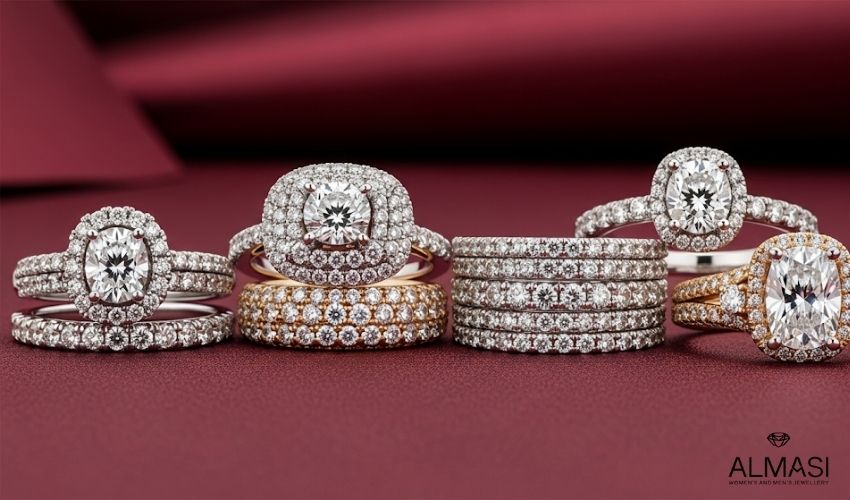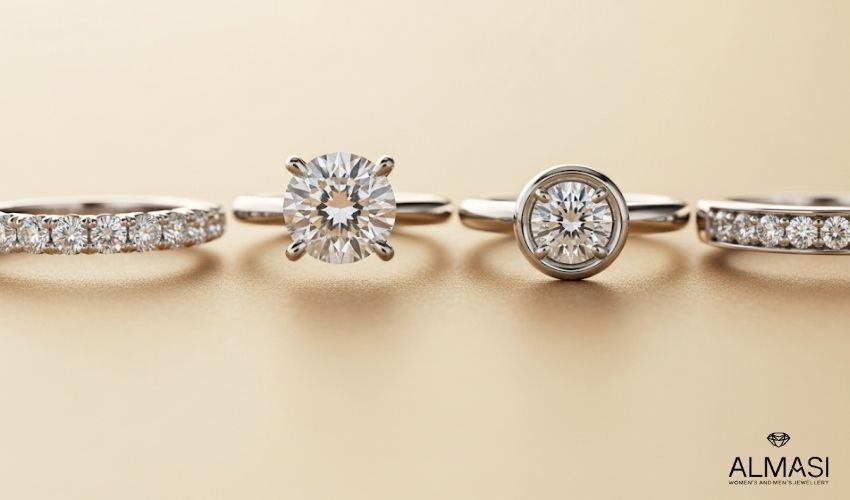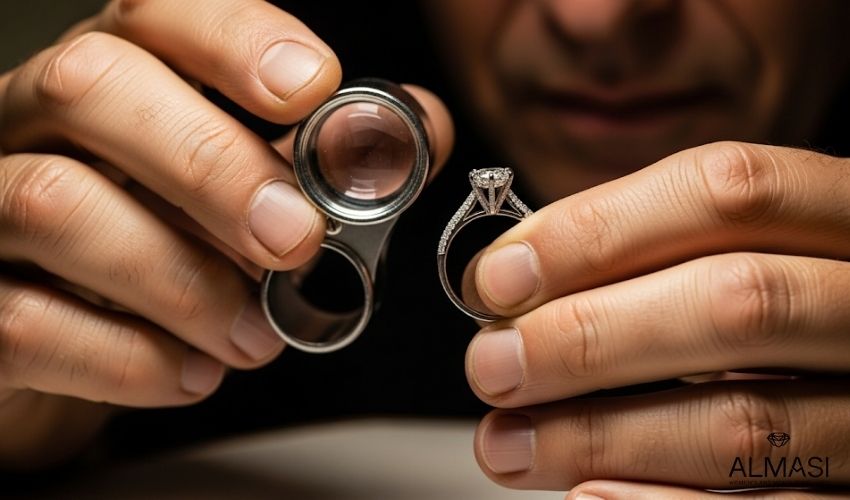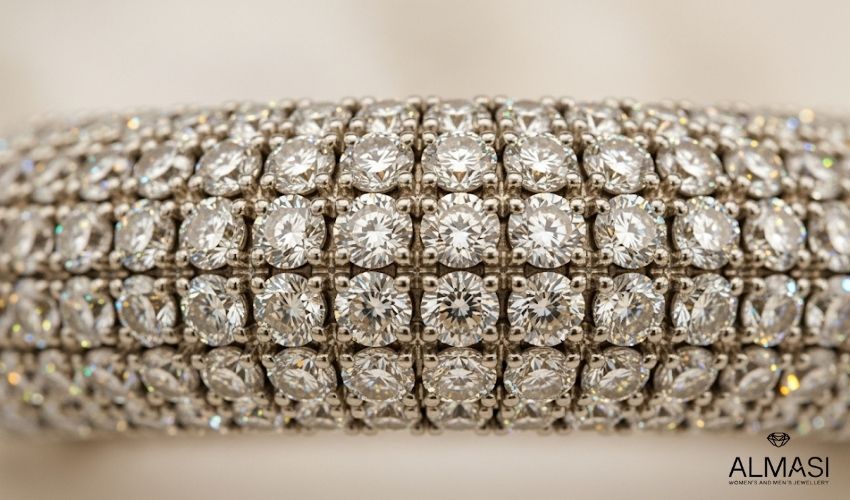Pave (pronounced “pah-vay”) represents one of jewelry’s most brilliant setting techniques, creating pave jewelry. Small diamonds or gemstones get placed so close together that you can barely see the metal holding them in place. It creates what appears to be a solid surface of sparkling stones.
The technique gets its name from the French word for “paved” because the finished result looks like a street paved with tiny, glittering cobblestones. Jewelers secure each stone using microscopic metal beads or prongs that remain nearly invisible to create this effect. Important characteristics of pave settings:
- Stones typically measure less than 0.1 carats each
- Metal prongs or beads hold stones in place
- Creates continuous sparkle across the surface
- Often uses “melee diamonds” (very small diamonds)
- Requires precise craftsmanship and skill
Types of Pave Settings

Modern jewelry features several distinct pave variations, each offering different visual effects and durability levels.
Micro Pave
Micro pave uses extremely small diamonds weighing less than 0.01 carats each. This setting can hold 50 or more tiny stones and creates the most delicate, refined appearance. Jewelers need exceptional skill to execute micro pave because of the precision required.
French Pave (Fishtail Pave)
French pave features V-shaped metalwork that resembles fishtail patterns. This style shows slightly more metal than other pave types but creates beautiful texture and vintage appeal. The zigzag pattern adds visual interest while maintaining maximum sparkle.
U-Cut Pave
According to GIA, U-cut pave uses U-shaped grooves cut into the metal surface. This technique creates a higher diamond-to-metal ratio, allowing more light to hit the stones for increased brilliance. The scalloped pattern produces exceptional fire and sparkle.
Petite Pave
Petite pave uses smaller prongs than standard pave settings. This makes individual diamonds more visible and prominent while maintaining the continuous sparkle effect.
Bright-Cut Pave (Channel-Set Pave)
Bright-cut pave provides extra protection by surrounding stones with small metal walls. This traditional style offers more durability but reduces some sparkle compared to other pave types.
Pave vs. Other Diamond Settings

| Setting Type | Visibility | Durability | Cost | Sparkle Level |
| Pave | Minimal metal visible | Moderate | Cost-effective | Maximum continuous sparkle |
| Prong | Metal claws visible | High | Varies | Individual stone focus |
| Bezel | Metal surrounds stone | Highest | Higher | Reduced but secure |
| Channel | Metal strips hold stones | High | Moderate | Linear sparkle |
Prong settings hold individual stones with visible metal claws, showcasing each diamond separately rather than creating continuous sparkle. Bezel settings completely surround each stone with metal for maximum protection but reduce light entry. Channel settings secure stones between metal strips, perfect for straight lines but limited in design flexibility.
Advantages of Pave
- Maximum sparkle potential: Pave settings create more brilliance than single large stones by reflecting light from multiple surfaces. The continuous diamond surface catches light from every angle.
- Cost-effective luxury: Using many small diamonds costs significantly less than one large stone of equivalent total weight. This allows buyers to achieve a high-end look without premium pricing.
- Enhances center stones: Pave bands make center diamonds appear larger by creating a halo effect. The surrounding sparkle draws attention to the main stone.
- Design flexibility: Pave works on rings, bracelets, earrings, pendants, and watches. Jewelers can create intricate patterns and unique shapes using this technique.
Disadvantages of Pave
- Maintenance requirements: Small stones in pave settings need professional inspection 1-2 times yearly. The delicate prongs can loosen over time with daily wear.
- Stone loss risk: Pave diamonds can fall out if the setting gets damaged or prongs become loose. Active lifestyles increase this risk significantly.
- Resizing challenges: Changing ring sizes becomes difficult or impossible with pave settings because altering the band affects stone placement.
- Cleaning complexity: The small spaces between stones trap dirt and oils, making thorough cleaning more challenging than simple settings.
Daily Care Practices
- Remove rings before cleaning, exercising, or manual work
- Store pieces separately to prevent scratching
- Avoid contact with harsh chemicals and lotions
Cleaning Routine
- Soak in warm, soapy water for several minutes
- Use a soft baby toothbrush to gently clean around stones
- Rinse thoroughly with clean water
- Pat dry with soft cloth and air-dry completely
Professional Maintenance
- Schedule yearly inspections with qualified jewelers
- Check for loose stones or damaged prongs
- Verify warranty coverage for stone replacement
The Hidden Truth About Pave Quality

After examining hundreds of pave pieces, I have learned that setting quality matters more than diamond grade in pave jewelry. Many manufacturers use lower-color diamonds (H-I instead of D-F) in pave because the small size makes color differences nearly invisible. However, poor craftsmanship shows immediately through uneven stone placement or weak prong work.
Professional tip: Examine pave pieces under magnification before buying. Look for consistent stone alignment, uniform spacing, and secure prong work. A well-executed pave setting using I-color diamonds will outperform poorly set D-color stones every time.
Buyer beware: Mass-produced pave jewelry often uses thinner metal and weaker prongs to reduce costs. This increases stone loss risk significantly. Invest in quality craftsmanship from established jewelers like AlMasi who offer stone replacement warranties.
FAQs About Pave Jewelry
Do pave diamonds fall out easily?
Pave diamonds stay secure when properly maintained, but the small prongs can loosen with heavy wear or impact. Regular professional inspections prevent stone loss by catching loose settings early. Quality pave work from skilled jewelers reduces fallout risk significantly.
How much does pave jewelry cost compared to other settings?
Pave settings typically cost 20-40% less than equivalent carat weight in larger stones because small diamonds cost less per carat. However, the intricate labor required for setting many tiny stones can increase manufacturing costs compared to simple solitaire settings.
Can you resize pave rings?
Resizing pave rings proves difficult or impossible because changing the band size disrupts the stone pattern. Most jewelers avoid resizing pave pieces, especially those with stones covering the entire band. Consider sizing carefully before purchase to avoid this limitation.


